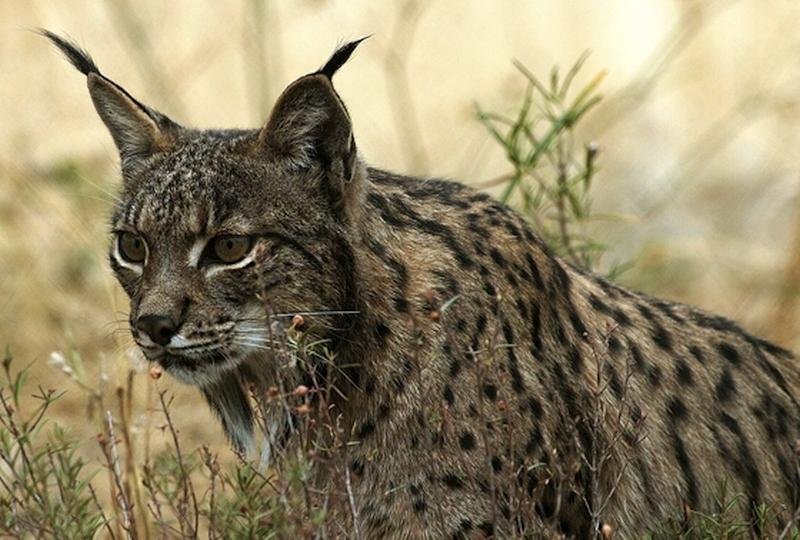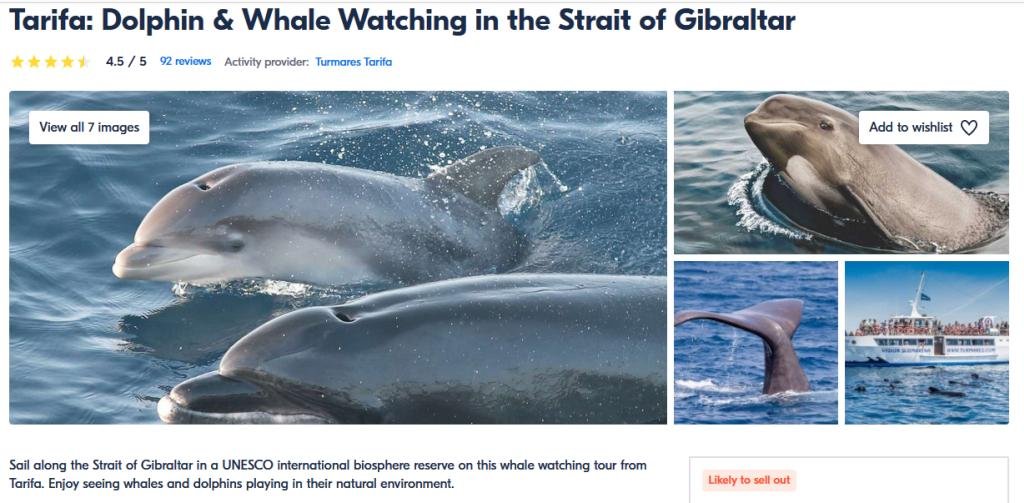Mammals that you might see whilst on a walking or wildife holiday in Spain
There are well over 100 species of mammals in Spain ranging from the tiny shrews to the enormous whales. There are species that live in high mountain zones such as Chamois (Rupicapra pyrenaica), Alpine marmot (Marmota marmota) and Mouflon a type of wild sheep (Ovis musimon) and at the opposite end of the scale, marine mammals such as Long-finned pilot whales (Globicephala melaena), Bottlenose (Tursiops truncatus) and Striped Dolphins (Stenella coeruleoalba).
The mammals of Spain vary from the better known Wild Boar (Sus scrofa) and Red Deer (Cervus elaphus hispanicus) to the last remaining numbers of the endangered Wolf (Canis lupus signatus) and Brown Bear (Ursus arctos) and further to the little known semi aquatic Pyrenean Desman (Galemys pyrenaicus).
Over 30 species of bat in Spain
There is also a large bat population with 30 species of bats currently known to live in Iberia (see the full list below). The Greater Noctule Bat (Nyctalus lasiopterus) has recently been the subject of studies as it is thought to be preying on small migrating birds that fly through the area of Doñana National Park at night.
Wildside Holidays – Spain
If you’re interested in discovering the natural parks and wildlife of Spain, Wildside Holidays is the perfect resource for you. Our platform offers comprehensive information on the country’s national parks, wildlife holidays, and tours that allow you to observe Spanish mammals and wildlife in their natural habitats. https://wildsideholidays.co.uk
The below list of mammals in Spain is an ongoing project.
Do you have any images we can use to improve the information pages? leave a comment or send us an email (clive@wildsideholidays.co.uk)
- Cantabrian Brown Bear – Ursus arctos – Oso Pardo Cantábrico
- Iberian Lynx – Lynx pardinus – Lince Ibérico
- Iberian Wolf – Canis lupus signatus – Lobo Ibérico
- Iberian red fox – Vulpes vulpes Silacea – Zorro
- European wildcat – Felis silvestris – Gato Montes
- Otter – Lutra lutra -Nutria Europea
- Common genet – Genetta genetta – Gineta
- Egyptian mongoose – Herpestes ichneumon widdringtonii – Meloncillo
- European beaver – Castor fiber – Castor Europeo
- Stone marten (Martes foina) Garduña
- European badger – Meles meles – Tejon
- European pine marten – Martes martes – Marta
- European polecat – Mustela putorius – Turón
- European mink – Mustela lutreola – Vison europea
- American mink – Neovison vison – Vison Americano (Introduced and invasive)
- Stoat /Ermine – Mustela erminea – Armiño
- Least weasel – Mustela nivalis – Comadreja
- Alpine marmot – Marmota marmota – Marmota alpina
- European bison – Bison bonasus – Bisonte europeo
- Spanish Ibex (Capra pyrenaica hispanica) Cabra montés
- Pyrenean chamois – Rupicapra pyrenaica – Rebeco
- Barbary sheep – Ammotragus lervia – Arrui
- European mouflon – Ovis aries musimon – Muflon
- Red deer (Cervus elaphus hispanicus) Ciervo
- Fallow deer – Dama dama – Gamo
- Roe deer – Capreolus capreolus – Corzo
- Iberian Wild Boar – Sus scofra – Jabali
- Iberian Rabbit – Oryctolagus cuniculus algirus – Conejo europea
- Iberian hare – Lepus granatensis – Liebre ibérica
- Atelerix algirus – The North African hedgehog – Erizo moruno
- Erinaceus europaeus – The European hedgehog – Erizo común
- Pyrenean desman – Galemys pyrenaicus – desman ibérico
- The black rat (Rattus rattus) and the brown rat (Rattus norvegicus)
- Common Racoon – Procyon lotor – Mapache boreal o Racuna
- Barbary macaque – Macaca sylvanus – Macaco de berbera
Marine mammals of Spain
Spain is home to a diverse range of marine mammal species, including several types of whales, dolphins, and seals. Notably, some of the most common species found in Spanish waters include the common dolphin, bottlenose dolphin, and the sperm whale. Furthermore, the waters surrounding the Canary Islands are particularly rich in marine life, with species such as the Risso’s dolphin, Bryde’s whale, and the short-finned pilot whale frequently observed in the area. In addition to these species, the Mediterranean coast of Spain is home to the Mediterranean monk seal, one of the most endangered seal species globally. To ensure the preservation of these marine mammal populations and their habitats, conservation efforts are in place in Spain.
Dolphins
- Common bottlenose dolphin or Atlantic bottlenose dolphin – Tursiops truncatus -Delfín mular
- Striped dolphin – Stenella coeruleoalba – Delfín listado
- Short-beaked common dolphin – Delphinus delphis – Delfín común
- Rough-toothed dolphin – Steno bredanensis – Delfín de dientes rugosos
- Atlantic spotted dolphin – Stenella frontalis – Delfín moteado Atlántico
- Risso’s dolphin – Grampus griseus – Calderón gris
- False killer whale Pseudorca crassidens – Falsa orca
- Killer whale – Orcinus orca – Orca
Dolphin & Whale Watching in the Strait of Gibraltar
Sail along the Strait of Gibraltar in a UNESCO international biosphere reserve on this whale watching tour from Tarifa. Enjoy seeing whales and dolphins playing in their natural environment.
Whales
- Short-finned pilot whale – Globicephala macrorhynchus – Calderón tropical
- Fin whale – Balaenoptera physalus – Rorcual común
- Sei whale – Balaenoptera borealis -Rorcual norteño
- Sperm whale – Physeter macrocephalus – Cachalote
- Cuvier’s beaked whale – Ziphius cavirostris – Zifio común
Bat species in Spain
Spain boasts a diverse array of bat species, with over 30 species documented within its borders. Notably, some of the most common species in the country include the greater horseshoe bat, the lesser horseshoe bat, the common pipistrelle, and the serotine bat. As important ecological players, bats in Spain play crucial roles as pollinators, seed dispersers, and insect predators, providing essential ecosystem services such as pest control. Despite their importance, many bat species in Spain are threatened by various factors, including habitat loss, climate change, and human disturbance. Consequently, conservation efforts are in place to protect these bats and their habitats to ensure that they continue to thrive and provide essential services.
The bat list for Spain
- Barbastella barbastellus – Barbastelle – barbastela or murciélago de bosque
- Eptesicus serotinus –Serotine bat – murciélago hortelano
- Hypsugo savii – Savi’s pipistrelle – murciélago montañero o de montaña
- Miniopterus schreibersi – Schreiber’s bat – murciélago de cueva
- Myotis alcathoe – Alcathoe bat – murciélago ratonero bigotudo pequeño
- Myotis bechsteini – Bechstein’s bat – murciélago ratonero forestal
- Myotis blythii – Lesser mouse-eared bat – murciélago ratonero mediano
- Myotis capaccinii – Long-fingered bat – murciélago ratonero patudo
- Myotis daubentoni – Daubenton’s bat – murciélago ratonero ribereño
- Myotis emarginata – Geoffroy’s bat – murciélago ratonero pardo
- Myotis myotis – Greater mouse-eared bat – murciélago ratonero grande
- Myotis mystacinus – Whiskered bat – murciélago ratonero bigotudo
- Myotis nattereri – Natterer’s bat – murciélago ratonero gris
- Nyctalus lasiopterus – Greater noctule – nóctulo grande
- Nyctalus leisleri – Leisler’s bat – nóctulo pequeño
- Nyctalus noctula – Noctule (or great bat) – nóctulo mediano
- Pipistrellus maderensis – Madeira pipistrelle – murciélago de Madeira
- Pipistrellus mediterraneus – Common pipistrelle – murciélago enano (or de Cabrera)
- Pipistrellus pipistrellus – Pipistrelle or common bat – murciélago enano
- Pipistrellus kuhlii – Kuhl’s pipistrelle – murciélago de borde claro
- Pipistrellus pygmaeus – soprano pipistrelle – murciélago de Cabrera
- Plecotus auritus – Brown long-eared bat – murciélago orejudo dorado
- Plecotus austriacus – Grey long-eared bat – murciélago orejudo gris
- Plecotus teneriffae – Tenerife long-eared bat – murciélago orejudo canario
- Plecotus macrobullaris – Alpine long-eared bat or mountain long-eared bat – murciélago orejudo alpino
- Rhinolophus euryale – Mediterranean horseshoe bat – murciélago mediterráneo de herradura
- Rhinolophus ferrumequinun – Greater horseshoe bat – murciélago grande de herradura
- Rhinolophus hipposideros – Lesser horseshoe bat – murciélago pequeño de herradura
- Rhinolophus mehelyi – Mehely’s horseshoe bat – murciélago mediano de herradura
- Tadarida teniotis – European free-tailed bat – murciélago rabudo
The Rock Hyrax
The Rock hyrax is not present in Spain but has a fascinating connection to the Iberian Peninsular. Read about it here: https://wildsideholidays.co.uk/the-fascinating-link-between-hispania-and-a-unique-creature-the-rock-hyrax/
Looking for something specific? Use the search system in the sidebar top right of all pages.
FAQ: Mammals of Spain – Species, Regions, and Wildlife Travel Tips
Spain hosts over 100 species of mammals, ranging from tiny shrews and bats to large mountain and marine mammals. Mountain zones like the Pyrenees and Picos de Europa shelter Chamois, Alpine Marmots, and Mouflon, while coastal regions and islands offer sightings of Long-finned Pilot Whales, Striped Dolphins, and Bottlenose Dolphins.
Spain is home to critically endangered species such as the Iberian Lynx, Iberian Wolf, and Cantabrian Brown Bear. These top predators are protected in isolated populations, mostly in the north and southwest. Rarer species like the Pyrenean Desman, a semi-aquatic insectivore, also highlight Spain’s biodiversity.
With over 30 bat species, Spain supports vital bat diversity. Species like the Greater Noctule Bat—which may prey on migratory birds in Doñana—play roles in pest control and pollination. Others, including the Lesser Horseshoe Bat and Serotine Bat, face threats from habitat loss and human activity.
Spanish waters are rich in marine mammal species, including Common Dolphins, Bryde’s Whales, Risso’s Dolphins, and the endangered Mediterranean Monk Seal. The Canary Islands and Strait of Gibraltar are biodiversity hotspots, while the Mediterranean hosts year-round and migratory species.
The Cantabrian Mountains are best for seeing Brown Bears, while wolves are still found in Castilla y León and Galicia. Andújar Natural Park in Andalusia is the top spot for Iberian Lynx sightings. These regions often require guided wildlife tours for responsible observation.
Spain’s smaller predators include the European Wildcat, Otter, Genet, Pine Marten, Badger, Polecat, and Egyptian Mongoose. The American Mink, an invasive species, also competes with native carnivores like the European Mink in river habitats.
Doñana National Park supports over 30 mammal species, including Rabbits, Otters, Foxes, Badgers, and multiple bat and rodent species. It’s also home to the Iberian Lynx. This park is crucial for conservation and a top destination for wildlife watchers.
Each Spanish region features unique ecosystems. Andalusia hosts arid sierras and lynx habitat; Galicia has lush Atlantic forests; the Canary Islands are volcanic with endemic species; and Castilla y León offers plateaus and wolf territories. These regional differences shape the distribution of mammals.
es. Platforms like Wildside Holidays offer in depth information about wildlife-focused trips across Spain. These include private tours, walking holidays, and nature park guides. They connect travelers to licensed local guides with expertise in mammals, birds, and flora.
Wildside Holidays also provides information on birds, reptiles, amphibians, and insect life. Popular nature experiences include visiting Biosphere Reserves, Geoparks, and routes like Caminito del Rey. The Iberia Nature Forum helps visitors identify wildlife and plan eco-travel.

